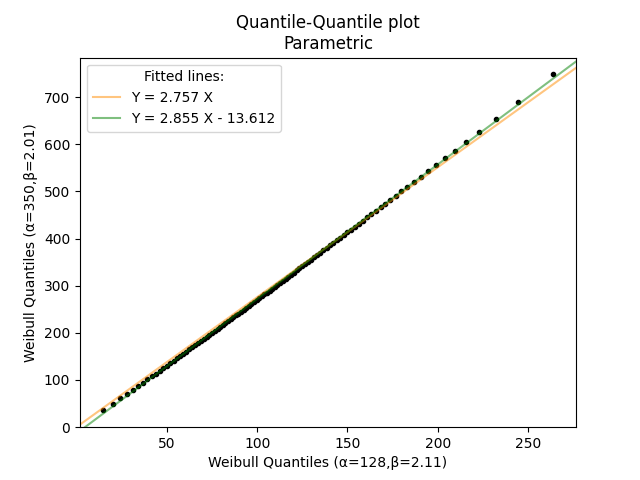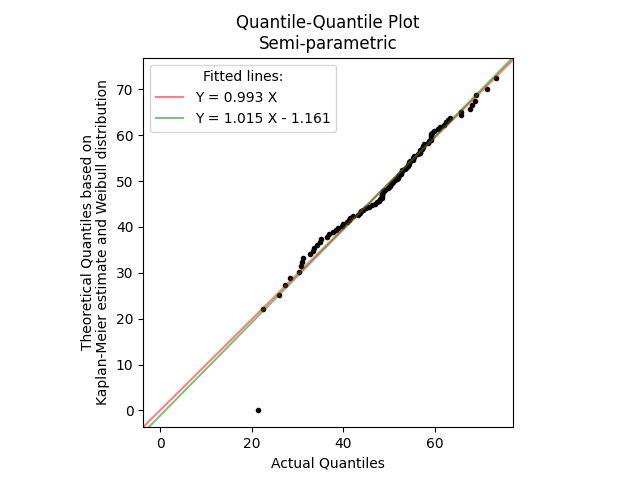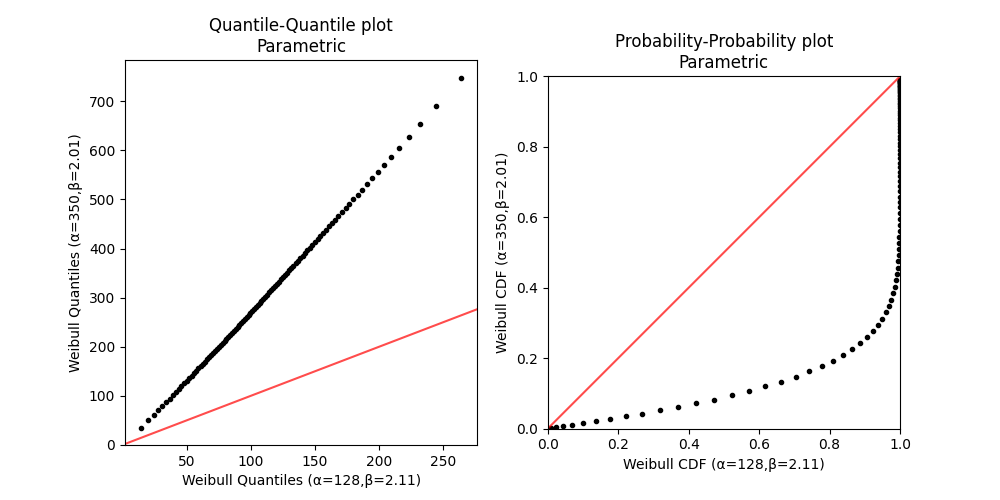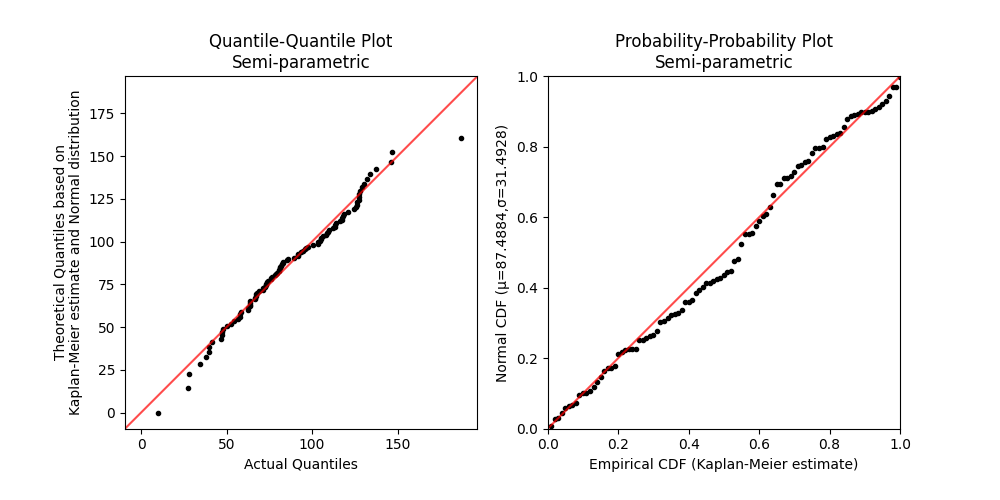
Quantile-Quantile plots
This section contains two different styles of quantile-quantile plots. These are the fully parametric quantile-quantile plot (reliability.Probability_plotting.QQ_plot_parametric) and the semi-parametric quantile-quantile plot (reliability.Probability_plotting.QQ_plot_semiparametric). These will be described separately below. A quantile-quantile (QQ) plot is made by plotting time vs time for shared quantiles. A quantile is the time at which a given fraction (from 0 to 1) has failed. In other words we are asking what fraction has failed after a certain time and comparing that fraction for each distribution. If the two distributions are identical then the QQ plot would form a straight line at 45 degrees (assuming the axes are scaled identically). Anything other than a 45 degree line tells us that one distribution leads or lags the other in the fraction failing for a given period of time. Everywhere we say ‘time’ we may equivalently say any other life unit (e.g. cycles, miles, landings, rounds, etc.).
Parametric Quantile-Quantile plot
To generate this plot we calculate the failure units (these may be units of time, strength, cycles, landings, rounds fired, etc.) at which a certain fraction has failed (0.01,0.02,0.03…0.99). We do this for each distribution so we have an array of failure units and then we plot these failure units against each other. The time (or any other failure unit) at which a given fraction has failed is found using the inverse survival function. If the distributions are identical then the QQ plot will be a straight line at 45 degrees. If the distributions are similar in shape, then the QQ plot should be a reasonably straight line (but not necessarily a 45 degree line) indicating the failure rates are proportional but not identical. By plotting the failure times at equal quantiles for each distribution (and finding the gradient of the line) we can obtain a conversion between the two distributions. Such conversions are useful for accelerated life testing (ALT) to easily convert field time to test time.
API Reference
For inputs and outputs see the API reference.
Example 1
In the example below, we have determined that the field failures follow a Weibull distribution (α=350, β=2.01) with time represented in months. By using an accelerated life test we have replicated the failure mode and Weibull shape parameter reasonably closely and the Lab failures follow a Weibull distribution (α=128, β=2.11) with time measured in hours. We would like to obtain a simple Field-to-Lab conversion for time so we know how much lab time is required to simulate 10 years of field time. The QQ plot will automatically provide the equations for the lines of best fit. If we use the Y=m.X equation we see that Field(months)=2.757×Lab(hours). Therefore, to simulate 10 years of field time (120 months) we need to run the accelerated life test for approximately 43.53 hours in the Lab.
from reliability.Probability_plotting import QQ_plot_parametric
from reliability.Distributions import Weibull_Distribution
import matplotlib.pyplot as plt
Field = Weibull_Distribution(alpha=350,beta=2.01)
Lab = Weibull_Distribution(alpha=128,beta=2.11)
QQ_plot_parametric(X_dist=Lab, Y_dist=Field)
plt.show()

Semiparametric Quantile-Quantile plot
This plot is still a Quantile-Quantile plot (plotting failure units vs failure units for shared quantiles), but instead of using two parametric distributions, we use the failure data directly as one set of quantiles. We then estimate what the quantiles of the parametric distribution would be and plot the parametric (theoretical) failure units against the actual failure units. To generate this plot we begin with the failure units (these may be units of time, strength, cycles, landings, etc.). We then obtain an emprical CDF using either Kaplan-Meier, Nelson-Aalen, or Rank Adjustment. The empirical CDF gives us the quantiles we will use to equate the actual and theoretical failure times. Once we have the empirical CDF, we use the inverse survival function of the specified distribution to obtain the theoretical failure units and then plot the actual and theoretical failure units together. The primary purpose of this plot is as a graphical goodness of fit test. If the specified distribution is a good fit to the data then the QQ plot should be a reasonably straight line along the diagonal.
API Reference
For inputs and outputs see the API reference.
Example 2
In the example below, we generate 100 random samples from a Normal distribution. We then fit a Weibull_2P distribution to this data and using QQ_plot_semiparametric we compare the actual quantile (the original data) with the theoretical quantiles (from the fitted distribution). The lines of best fit are automatically provided and the Y=0.992X shows the relationship is very close to perfect with only some deviation around the tails of the distribution. The final example on this page compares a QQ_plot_semiparametric with a PP_plot_semiparametric for the same dataset to show the differences between the two.
from reliability.Probability_plotting import QQ_plot_semiparametric
from reliability.Fitters import Fit_Weibull_2P
from reliability.Distributions import Normal_Distribution
import matplotlib.pyplot as plt
data = Normal_Distribution(mu=50,sigma=12).random_samples(100)
fitted_dist = Fit_Weibull_2P(failures=data,print_results=False,show_probability_plot=False).distribution
QQ_plot_semiparametric(X_data_failures=data,Y_dist=fitted_dist)
plt.show()

Comparing PP plots with QQ plots
Normally, it is not practical to compare the output of the two plots as they are so vastly different and are used for different purposes, but the comparison below is provided for the reader’s understanding. The differences between these plots are so significant because one is the time at which the fraction has failed (the Quantile) and the other is the fraction failing at a given time (the CDF). Parametric PP plots are not very common as their only use is in providing a graphical understanding of the differences between the CDFs of two distributions, such as how one lags or leads the other at various times. See Probability-Probability plots for more detail on the uses of parametric PP plots.
Example 3
In this example we compare a QQ_plot_parametric with a PP_plot_parametric for the same pair of distributions.
from reliability.Probability_plotting import QQ_plot_parametric, PP_plot_parametric
from reliability.Distributions import Weibull_Distribution
import matplotlib.pyplot as plt
Field = Weibull_Distribution(alpha=350,beta=2.01)
Lab = Weibull_Distribution(alpha=128,beta=2.11)
plt.figure(figsize=(10,5))
plt.subplot(121)
QQ_plot_parametric(X_dist=Lab, Y_dist=Field,show_diagonal_line=True,show_fitted_lines=False)
plt.subplot(122)
PP_plot_parametric(X_dist=Lab, Y_dist=Field,show_diagonal_line=True)
plt.show()

Example 4
In this example we compare a QQ_plot_semiparametric with a PP_plot_semiparametric for the same dataset. Both plots are intended to be used as graphical goodness of fit tests. In a PP plot we get a lot of resolution in the center of the distributions, but less at the tails, whereas the QQ plot gives very good resolution at the tails, but less in the center. Because most data analysts are more concerned about the extremes (tails) of a distribution, QQ plots are the more commonly used plot between the two.
from reliability.Probability_plotting import PP_plot_semiparametric, QQ_plot_semiparametric
from reliability.Fitters import Fit_Normal_2P
from reliability.Distributions import Weibull_Distribution
import matplotlib.pyplot as plt
data = Weibull_Distribution(alpha=100,beta=3).random_samples(100) #create some data
dist = Fit_Normal_2P(failures=data,print_results=False,show_probability_plot=False).distribution #fit a normal distribution
plt.figure(figsize=(10,5))
plt.subplot(121)
QQ_plot_semiparametric(X_data_failures=data,Y_dist=dist,show_fitted_lines=False,show_diagonal_line=True)
plt.subplot(122)
PP_plot_semiparametric(X_data_failures=data,Y_dist=dist)
plt.show()
